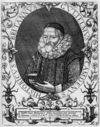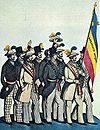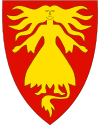Portal:Heraldry
Welcome to the Heraldry and Vexillology Portal!


Vexillology (from the Latin vexillum, a flag or banner) is the scholarly study of flags, including the creation and development of a body of knowledge about flags of all types, their forms and functions, and of scientific theories and principles based on that knowledge. Flags were originally used to assist military coordination on the battlefield, and have evolved into a general tool for signalling and identification, particularly identification of countries.
Heraldry encompasses all of the duties of a herald, including the science and art of designing, displaying, describing and recording coats of arms and badges, as well as the formal ceremonies and laws that regulate the use and inheritance of arms. The origins of heraldry lie in the medieval need to distinguish participants in battles or jousts, whose faces were hidden by steel helmets.
Selected biography

William Camden (May 2, 1551–November 9, 1623) was an English antiquarian and historian. He wrote Britannia, the first topographical survey of the island of Great Britain, and Annales, the first detailed historical account of the reign of Elizabeth I of England. In 1597 he was appointed Clarenceux King of Arms to facilitate his research, the post carrying a salary, and the College of Arms at the time being a centre of antiquarian studies. The appointment, however, roused the jealousy of the herald Ralph Brooke, who in retaliation published an attack on Britannia, charging Camden with inaccuracy and plagiarism. Camden successfully defended himself against the charges in subsequent editions of the work. (more...)
Selected flag

The colors of the national flag of Romania (Romanian: Drapelul României) have a long history. Red, yellow and blue were found on late 16th-century royal grants of Michael the Brave, as well as shields and banners. During the Wallachian uprising of 1821, they were present on the canvas of the revolutionaries' flag and its fringes; for the first time a meaning was attributed to them: "Liberty (sky-blue), Justice (field yellow), Fraternity (blood red)". Article 124 of the 1866 Constitution of Romania provided that “the colors of the United Principalities will be Blue, Yellow and Red”. The order and placement of the colors were decided by the Assembly of Deputies in its session of 26 March 1867. Thus, following a proposal by Nicolae Golescu, they were placed just as in 1848.
On 30 December 1947, Romania was proclaimed a people’s republic and all the kingdom’s symbols were outlawed, including the coats of arms and the tricolor flags that showed them. According to article 101 of the 1948 Constitution, “The flag of the Romanian People’s Republic is composed of the colors: blue, yellow and red, arranged vertically. In the middle is placed the national coat of arms”. (more...)
Selected coat of arms

The Seal of Dartmouth College is the official insignia of Dartmouth College, an Ivy League university located in Hanover, New Hampshire, United States. Anglo-American law generally requires a corporate body to seek official government sanction, usually in the form of a charter, in order to operate. Such chartered bodies normally authenticate their official acts by marking them with a distinctive seal. The seal's design is usually complicated to avoid counterfeiting, but it can also express something about the institution's history or mission. Dartmouth College is one such chartered body, and it obtained its official seal in 1773. (more...)
Selected picture

Pursuivants in procession to St George's Chapel, Windsor Castle for the 2006 service of the Order of the Garter: Peter O'Donoghue, Bluemantle Pursuivant of Arms in Ordinary (left), Alastair Bruce of Crionaich, Fitzalan Pursuivant of Arms Extraordinary (right).
Did you know...
- ...that the Coat of arms of Lardal (pictured) in Norway features a hulder as a charge?
- ...that Yusak Pakage was sentenced to ten years in prison after raising the Morning Star flag?
- ...that merchant's marks, the precursors of hallmarks, printers' marks and modern-day trademarks, served in place of heraldic imagery, which could not be used by middle class traders and artisans?
- ...that the Fairy Flag is traditionally thought to have been a gift from the fairies to the chiefs of Clan Macleod?
- ...that the Canadian Heraldic Authority appointed three new Heralds Extraordinary in October 2006 – Albion, Capilano and Rouge?
Related portals
|
|
|
Heraldry Web resources
Authorities
- Belgium - The Council of Nobility, Flemish Heraldic Council and Council of Heraldry and Vexillology of the French Community
- Canada - Canadian Heraldic Authority and see also Public Register of Arms, Flags and Badges
- England, Wales, and Northern Ireland - The College of Arms
- Ireland - The Office of the Chief Herald of Ireland
- Netherlands - High Council of Nobility
- Portugal - Instituto da Nobreza Portuguesa
- Scotland - The Court of the Lord Lyon
- South Africa - South African Bureau of Heraldry
- Sweden - National Board of Heraldry, The National Archive
- United States Army - The United States Army Institute of Heraldry
Societies
- Greek Heraldry Society
- The Academy of Heraldic Science Czech republic
- The American College of Heraldry
- The American Heraldry Society
- The Augustan Society
- The Australian Heraldry Society Inc.
- Bulgarian Heraldry and Vexillology Society
- The Center for Research of Orthodox Monarchism
- Cambridge University Heraldic and Genealogical Society
- Chiltern Heraldry Group
- The College of Dracology
- Croatian Heraldic and Vexillologic Association
- The Finnish Heraldic Society
- Fryske Rie foar Heraldyk
- Hellenic Armigers Society
- Guild of Heraldic Artists
- Genealogical Society of Ireland
- Heraldry Research Institute (Japan)
- The Heraldry Society
- The Heraldry Society of Africa
- The Heraldry Society of New Zealand Inc.
- The Heraldry Society of Scotland
- The Heraldry Society of Southern Africa
- The Institute of Heraldic and Genealogical Studies
- The International Association of Amateur Heralds
- Italian Center of Vexillological Studies
- Lancashire Heraldry Group
- Macedonian Heraldry Society
- New England Historic Genealogical Society Committee on Heraldry
- Norwegian Heraldry Society
- Oxford University Heraldry Society
- Polish Heraldry Society
- Polish Nobility Confederation
- Real Academia Matritense de Heráldica y Genealogía - Royal Academy of Heraldry and Genealogy of Madrid
- Romanian Institute for Genealogy and Heraldry
- The Royal Heraldry Society of Canada
- The Russian College of HeraldryThe Russian College of Heraldry
- Serbian Heraldic Society
- Societas Heraldica Scandinavica
- Societas Heraldica Slovenica
- Swedish Heraldic Society
- Ukrainian Heraldry Society
- Royal Association Genealogical and Heraldic Office of Belgium
Vexillology
Software
- Coat of Arms Visual Designer web-based program
- Puncher Heraldry Program
- Blazonry Server - pyBlazon
- DrawShield - creates SVG shield or arms image from blazon
- CoaMaker - web-based tool
- Blazon95 and BLAZONS! 2000, older Windows applications
Texts
- Heraldry, historical and popular : with seven hundred illustrations (1863)
- A Complete Guide to Heraldry (1909)
Other
Wikimedia
The following Wikimedia Foundation sister projects provide more on this subject:
-
Commons
Free media repository -
Wikibooks
Free textbooks and manuals -
Wikidata
Free knowledge base -
Wikinews
Free-content news -
Wikiquote
Collection of quotations -
Wikisource
Free-content library -
Wikispecies
Directory of species -
Wikiversity
Free learning tools -
Wikivoyage
Free travel guide -
Wiktionary
Dictionary and thesaurus












